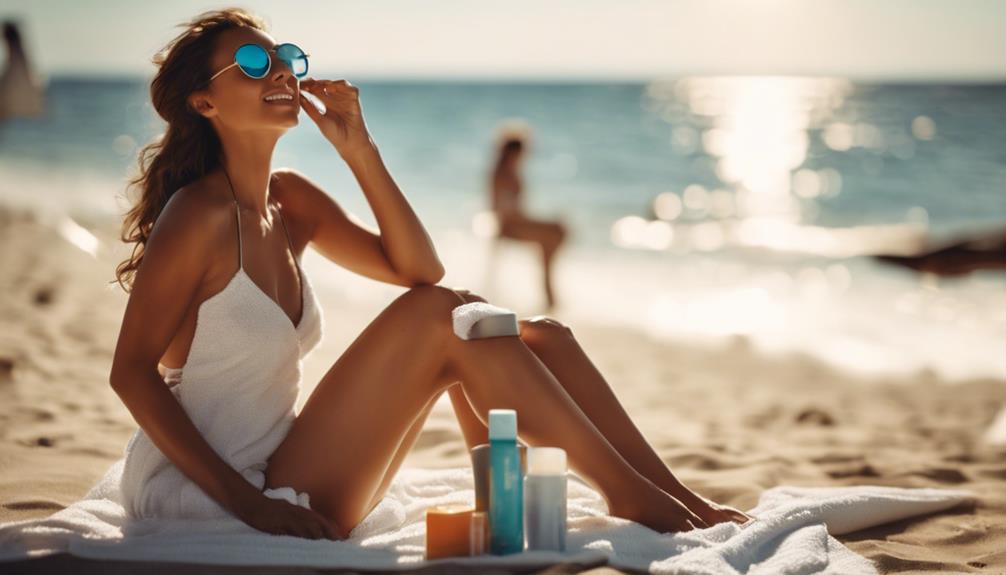To master the art of tanning, you should switch sides every 15-30 minutes to guarantee an even tan. This flipping action not only boosts your melanin production but also enhances your overall tanning experience. Always set a timer after applying sunscreen to remind yourself when to flip. Pay attention to your skin; if you feel stinging or discomfort, it's time to change positions. Remember to protect your skin with broad-spectrum SPF, and stay aware of signs of overexposure, like redness or fatigue. The key to effective tanning goes beyond just flipping—there's more you can discover to perfect your technique.
Key Takeaways
- Flip sides every 15-30 minutes to ensure an even tan and boost melanin production.
- Use a timer after applying SPF to remind you to switch positions.
- Change sides immediately if you feel stinging or discomfort to prevent overexposure.
- Fair skin should avoid peak sun hours; medium to dark skin can tan safely with protection.
Tanning Frequency and Techniques
To achieve an even tan and avoid unsightly tan lines, you should switch sides every 15-30 minutes while tanning.
Regularly flipping your position encourages melanin production, leading to a more uniform color.
Setting a timer after applying SPF can help remind you to make the switch.
Pay attention to your body; if you feel stinging or discomfort, it's time to change sides.
If you're using a stand-up tanning bed, you can cut down on the effort needed for flipping, which can be more convenient.
Remember, consistency is key to achieving that sun-kissed glow while preventing uneven patches.
Enjoy the process, and don't rush; a little patience goes a long way in mastering your tanning technique!
Skin Type and Tanning Safety
Understanding your skin type plays an essential role in determining safe tanning practices and optimizing your sun exposure. Knowing how your skin reacts to sunlight helps you enjoy the sun while minimizing risks.
Here are some key considerations:
- Fair skin: Tan in the morning or after 3 PM to reduce sunburn risk.
- Medium-light to brown skin: Can handle peak sun hours but still needs protection.
- Skin type awareness: Helps you choose the right tanning times.
- Melanin production: Flipping sides promotes even tanning and boosts melanin.
Importance of Sunscreen

Sunscreen is essential for protecting your skin from harmful UV rays and preventing long-term damage.
Using a broad-spectrum SPF of 15-30 is important, as it shields you from both UVA and UVB rays. Remember to apply it generously to all exposed areas, including often-missed spots like your ears and toes.
Reapply every two hours, or immediately after swimming or sweating, to maintain effective protection. Consistency is key; make sunscreen a part of your daily routine, even on cloudy days.
Regular dermatological check-ups can help monitor your skin health and catch any potential issues early.
Recognizing Overexposure Symptoms
Often, you might notice signs of overexposure after spending too much time in the sun, such as red, sunburned skin or dehydration symptoms like dizziness. Recognizing these symptoms early can help you take action to protect your skin and health.
Pay attention to your body's signals, and if you experience any of the following, it's time to seek shade and hydrate:
- Red, inflamed skin
- Dizziness or lightheadedness
- Nausea or headaches
- Dry mouth or excessive thirst
Ignoring these signs can lead to serious skin damage or heat-related illnesses.
Always prioritize your well-being while enjoying the sun, and don't hesitate to take breaks as needed.
Alternatives to Traditional Tanning

If you're looking to achieve a bronzed look without the risks associated with UV exposure, consider alternatives like spray tans or self-tanning products. These options let you control the depth of color while keeping your skin safe. Foods rich in beta-carotene and lycopene can also enhance a natural tan, making your glow last longer.
Here's a quick comparison of popular alternatives:
| Option | Benefits |
|---|---|
| Spray Tans | Instant color, even application |
| Self-Tanning Lotion | Customizable shade, easy to apply |
| Natural Foods | Nourishing, improves overall skin |
After tanning, apply moisturizer, take cool showers, and drink plenty of water for recovery. Avoid exfoliating immediately to let your skin rest.
Frequently Asked Questions
How Can I Achieve a Tan Faster Without Damaging My Skin?
To achieve a tan faster without damaging your skin, focus on using SPF, tan during safer hours, and flip positions regularly. Stay hydrated, and consider alternatives like self-tanners for a healthy glow without UV exposure.
What Are the Best Positions for Even Tanning?
Imagine basking under the sun's warm embrace. To achieve an even tan, lay flat, then switch to your side or back every 15-30 minutes, ensuring every inch of your skin gets that golden glow.
Can Indoor Tanning Beds Replace Outdoor Tanning?
Indoor tanning beds can effectively replace outdoor tanning for some, providing controlled exposure to UV rays. However, you still need to practice safety measures like using SPF and monitoring your skin's reaction to avoid overexposure.
How Long Should I Wait Between Tanning Sessions?
You should wait at least 24 hours between tanning sessions to allow your skin to recover. This helps prevent overexposure and reduces the risk of sunburn, ensuring a safer and more even tan over time.
What Should I Do if I Accidentally Get Sunburned?
If you accidentally get sunburned, cool your skin with aloe vera or a cold compress. Drink water to hydrate, and avoid further sun exposure until healed. Remember, a friend's sunburn taught you prevention's key!
Conclusion
In mastering the art of tanning, remember to switch sides and pay attention to your skin.
For instance, imagine Sarah, who diligently rotated every 20 minutes and applied sunscreen, achieving a beautiful, even tan without burns.
By prioritizing your skin's health and recognizing its signals, you can enjoy that radiant glow while minimizing risks.
So, embrace the sun wisely, and make every tanning session a safe and enjoyable experience!










